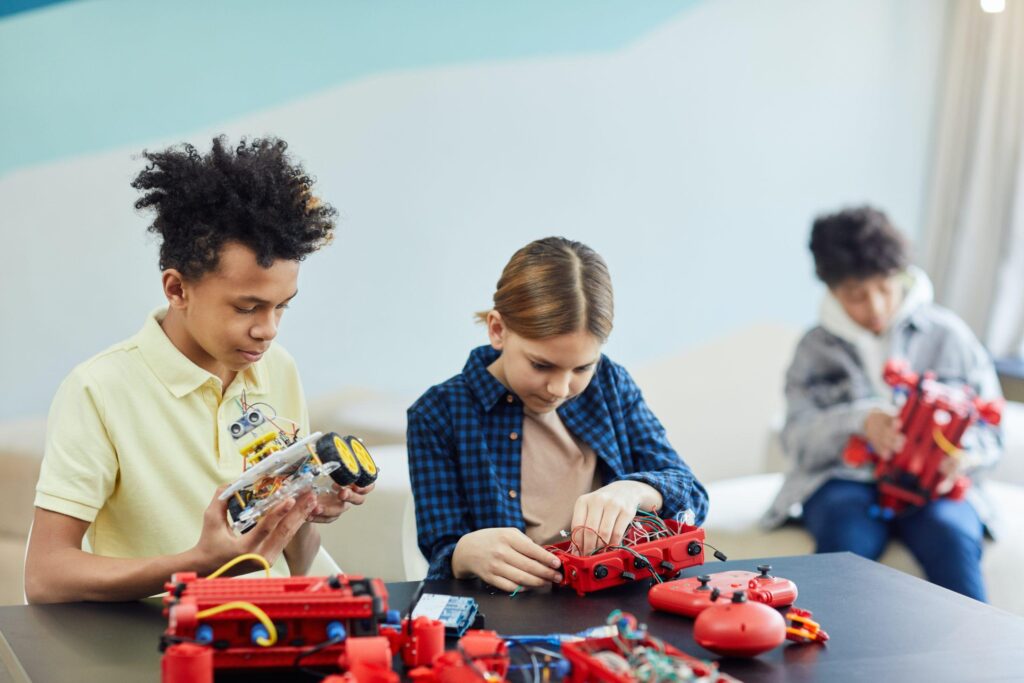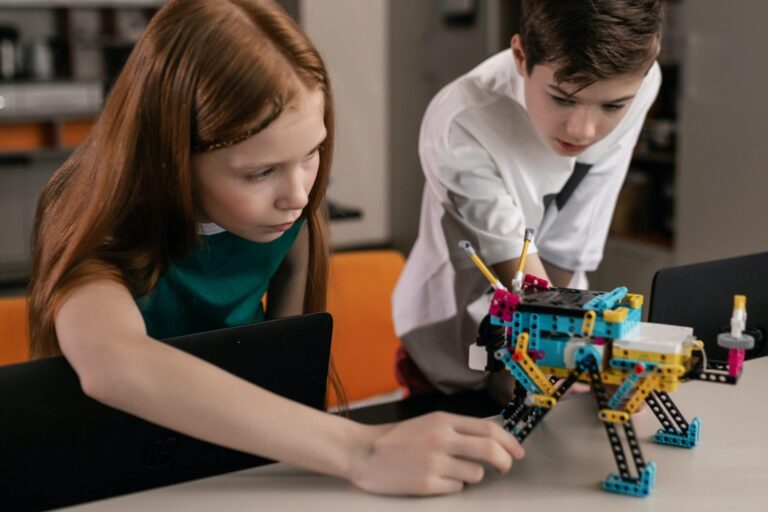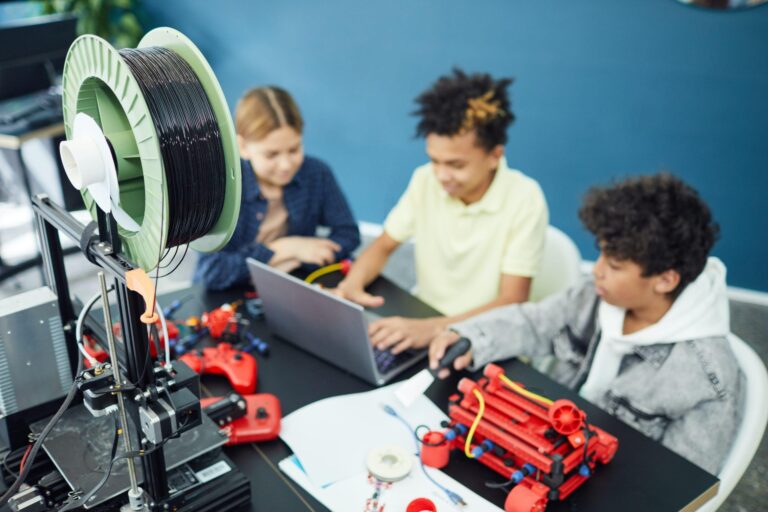Designing, creating, and using robots is a fun and exciting field of robotics. Robots are becoming more and more common in our world, ranging from basic toys to sophisticated machines employed in business and space research. Besides, they have transformed a variety of sectors, including healthcare, agriculture, and more. Kids have a great chance to study technology, engineering, and problem-solving in a practical and entertaining way through robotics. What’s more, robotics for Kids opens up a world of exciting opportunities for kids especially that involves encouraging creativity, fun, learning, and teamwork,
Are robots good for kids?
Robots can be a useful tool for kids, which allows them to develop in a variety of cognitive, technical, and social aspects. Here are some advantages.
1- Foster Creativity, Critical Thinking, Problem-Solving, and Teamwork
2- Provide an Early Introduction to Programming, Engineering, and Electronics
3- Inspire a Love for STEM Fields and Promote Diversity and Inclusivity
4- Encourage Hands-on Learning, Experimentation, and a Growth Mindset
5- Provide Opportunities for Creativity and Personalization, Igniting a Sense of Ownership and Pride
Types of Robotics Kits for Kids:
- Building Block Sets: These kits, which are popular among kids, offer an ideal basic for learning about simple machines and fundamental robotics ideas.
- Remote-Controlled Robots: Using portable devices, kids may learn ways to control robots, offering a fun start to robotics.
- Programmable Robots: These coding-capable kits give students advanced methods to learn about automation and programming.
Popular robotics kits include Dash and Dot, Ozobot, and LEGO Mindstorms are the examples. These kits include components such as sensors, motors, and software interfaces that let kids to construct, design, and experiment with their own robots, to make robotics education interactive and fun.
How to Get Started with Robotics:
To ensure safety and the right kit selection, some instructions must be given before the beginning of a robotics project. Equally important, the use of robots by kids should always be supervised, and kids should be taught basic safety steps. For instance, stay away from moving parts and be cautious around batteries and power sources. There are several online tutorials, books, and courses that offer detailed instructions and guidance to learn about robotics such as Code.org, FIRST Robotics, and Makeblock.
Fun Robotics Projects for Kids:
Kids can engage in countless entertaining and instructive projects using robots. Nor, kids can start with utilizing a kit to make a simple robot, then move on to more difficult tasks as they learn. For instance, they can design a robot to carry out particular tasks such as picking up objects, moving down a line, or navigating through a puzzle.
Additionally, they have the creative and innovative freedom to design and construct their own robot by using recycled materials or other resources. Also, guidelines, pictures, and videos can all be included in tutorials to make it simple for kids to follow along and complete their robotics projects successfully.
Real-World Applications of Robotics:
Kids ought to be exposed to how robotics is used for purposes other than toys and games in the real world. Moreover, there are many real-world uses for robotics in business, medicine, agriculture, and space exploration.
For instance, assembly, packing, and quality control jobs are performed by robots in factories. Furthermore, robots help in operations, therapy, and senior care in the field of healthcare. Other than that, robots are employed in agriculture for crop planting, harvesting, and monitoring. In addition, robots are utilized to conduct experiments, collect data, and explore other planets and moons, making robotics an essential component of space exploration.
Success stories of kids benefiting from learning about robotics:
- A 12-year-old schoolgirl named Sara joined a robotics club in a suburb of a large US city. Indeed, Sara managed to create and programme robots and gained practical experience in teamwork, creativity, problem-solving, and critical thinking.
Her confidence increased as a result of her competition success and she decided to pursue an engineering profession. Of course, she is an inventive engineer who creates remedies for contemporary issues of quality assurance, packing, and assembly.
- Jack, a 10-year-old kid from a rural public school in Canada, joined the robotics team at his school as he loved technology. Jack learnt how to create, construct, and programme robots with the support of a local technology firm, and he participated in regional tournaments.
Jack improved his ability to think critically, solve problems, work in a team, and present through the robotics programme. Therefore, he decided to further his studies in computer science as he was inspired by his success in robotics contests. Today, Jack works as a software developer, creating innovative software solutions.
- Ahmad, a 13-year-old student from Kuala Lumpur, Malaysia, joined his school’s robotics club and learned to design, build, and programme robots using LEGO Mindstorms kits. Through the robotics program, he developed critical thinking, problem-solving, teamwork, and communication skills.
Ahmad’s success in national, regional, and international robotics competitions boosted his confidence and inspired him to pursue a career in engineering. Today, he aspires to contribute to Malaysia’s technology and innovation landscape.
- Singaporean kid Mei Ling, 10, took part in a robotics enrichment course at her primary school. Previously, Mei Ling learnt to design, construct, and programme robots on various platforms. As a result, she improved her creativity, critical thinking, teamwork, and problem-solving skills during the programme.
Mei Ling actively engaged in local robotics contests, where she won awards for her creative approaches. She now hopes to work in robotics and continue her passion for STEM fields.
How to encourage kids and spark their interest in robotics?
- Kids can use their imagination and ingenuity to design their own special robots on paper by drawing robots, which is a fun and engaging activity. Plus, kids learn about the intriguing world of robots can be a terrific method to develop their artistic abilities, fine motor skills, and hand-eye coordination. Thus, drawing robots for kids can be a great way to foster their creativity, excite their interest in robotics, and give them a fun and informative project to do.
- Provide access to robotics kits or toys: Their attention and curiosity might be stimulated through practical experiences.
- Incorporate robotics into learning activities: Integrate robotics into their educational curriculum or extracurricular activities.
- Offer books, videos, and online resources: Offer resources that explore the realm of robotics and are age-appropriate.
- Attend robotics events or workshops: Look for local gatherings or contests that let you interact with professionals and get hands-on experience.
- Encourage experimentation and problem-solving: Robotics projects can promote creativity, critical thinking, and problem-solving abilities.
- Foster a growth mindset: Place an emphasis on tenacity, adaptability, and taking lessons from mistakes.
- Provide role models: Expose children to examples of successful people in the field of robotics in real life.
- Support collaboration and teamwork: Through group robotics projects, support communication and teamwork.
In conclusion, robotics is a fascinating and instructive field that has many advantages for kids. It encourages innovation, critical thinking, and problem-solving abilities while offering kids exposure to electronics, engineering, and programming.
Also, robotics projects can be entertaining and instructive, allowing kids to start off easy. The practicality and potential of robotics are highlighted by its real-world applications in business, medicine, agriculture, and space exploration. Kids’ curiosity can be piqued and they can be prepared for a future in a technologically advanced society by introducing them to robotics.


















